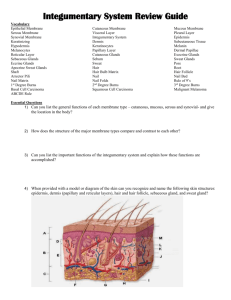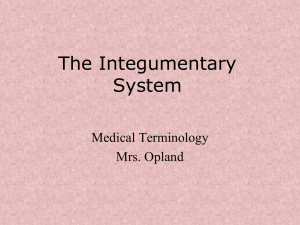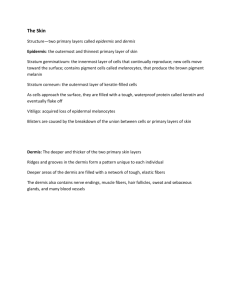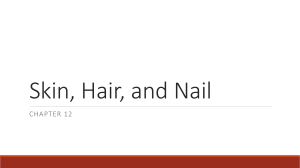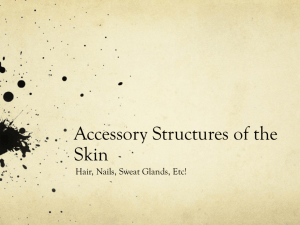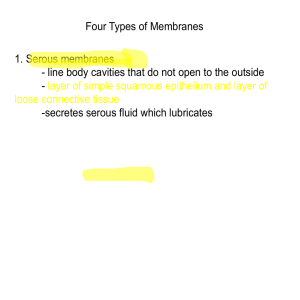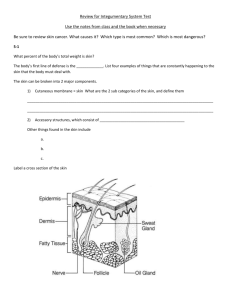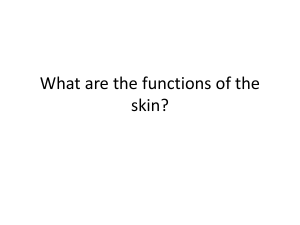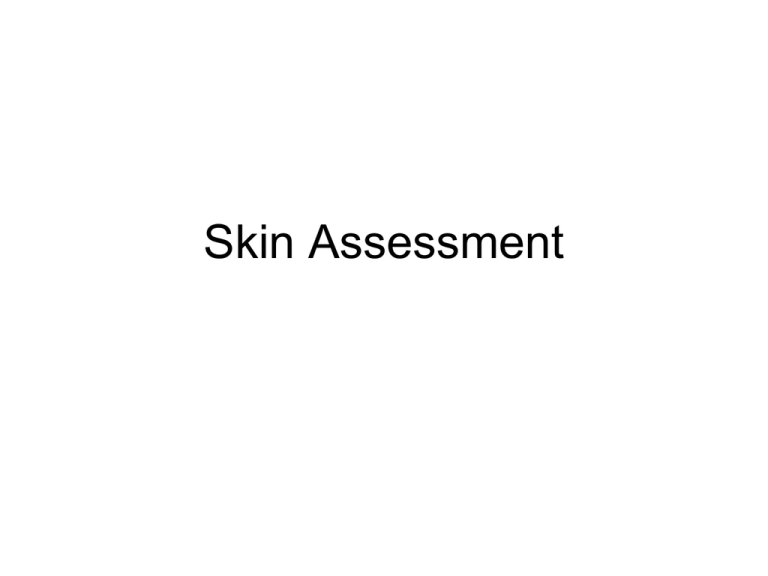
Skin Assessment
Skin Assessment
• A&P Review
– Epidermis - keratin
•
•
•
•
Squamous cells – stratum corneum
Basal cells – stratus germinativum
Avascular
Melanocytes
– Dermis – collagen
• Nerves, sensory receptors, blood vessels, lymph
• Sweat and sebaceous glands
A&P Continued
• Subcutaneous Layer
– Adipose tissue
– Cushioning and insulation
• Skin color
– Melanin
– Carotene
– Vascularity
Epidermal Appendages
• Hair – vestigial
• Sebaceous glands – secrete oil
• Sweat glands
– Eccrine –
• open directly on to skin
• sweat to reduce body temperature
– Apocrine –
• open into follicles
• Body odor
Nails
• Hardened keratin plate
• Nail bed is highly vascular tissue
underneath
• Generated by nail matrix
• Matrix covered by periungal folds
• Cuticle seals gap between matrix and
folds
Skin function
•
•
•
•
•
•
•
•
Protection/Barrier
Sensation
Temperature regulation
Identification
Communication
Wound Repair
Absorption/Excretion
Vitamin D
Developmental
• Infant
– Hair
– Ineffective Temperature regulation
• Puberty
– Apocrine Function
– Sebaceous glands
– Secondary sex characteristics
• Hair
• Areola
Aging Adult
• Atrophy of skin structures
– Subcutaneous fat loss
– Loss of elasticity
– Loss of collagen
– Loss of vascularity
• Increased risk for
– Infection
– Breakdown (ulcers)
– Bruising
History
•
•
•
•
•
•
•
Previous history of skin disease
Changes in pigmentation
Change in a mole
Excessive dryness or moisture
Pruritis
Rash or lesion
Medications
History
•
•
•
•
•
•
•
•
•
Hair loss
Change in nails
Environmental or occupational hazards
Self-care behaviors
Skin care
Wounds
Nail or foot problems
Diabetes, PVD
Tanning
Physical Exam
• Inspection and Palpation of Skin
• Skin color – Overall and local
– Pallor
– Erythema
– Cyanosis
– Jaundice
• Temperature
Physical Exam
•
•
•
•
•
•
Moisture
Texture
Thickness
Edema
Mobility and Turgor
Vascularity or Bruising
Physical Exam
• Lesions
– ABCDE
– Size, shape, configuration, distribution
– Primary or secondary
– Exudates
– Blanching
Physical Exam
• Inspection and Palpation of Hair and nails
• Hair
– Color
– Texture
– Distribution
– Lesions
Physical Exam
• Nails
– Shape and Contour
– Consistency
– Color
– Capillary refill
Vocabulary and Common Findings
• Lesion types, pg 151 - 155
–
–
–
–
Primary Lesions
Secondary Lesions
Vascular Lesions
Shapes and Configurations
• Other
– Psoriasis
– Tinea (capitis, corporis, cruris, pedis, versicolor)
– Eczema
Vocabulary
• Other continued
– Alopecia
– Hirsutism
– Hirsutism
– Clubbing of nail
– Onycholysis




